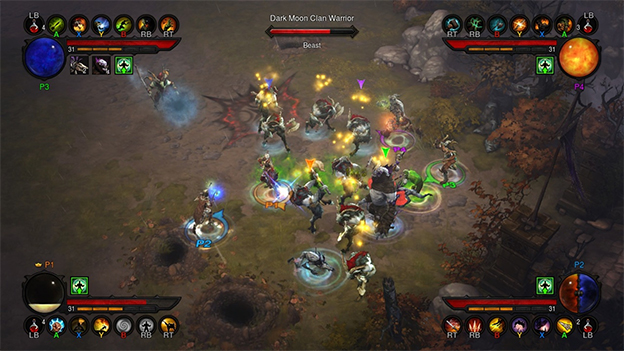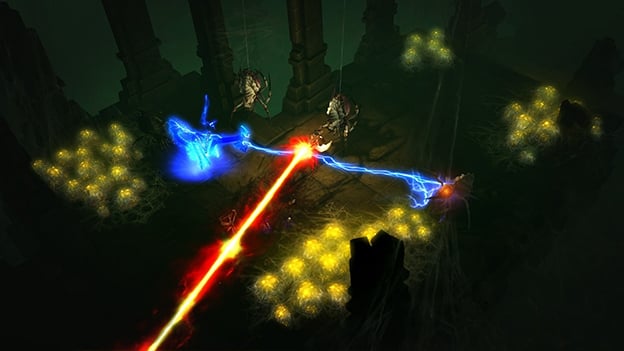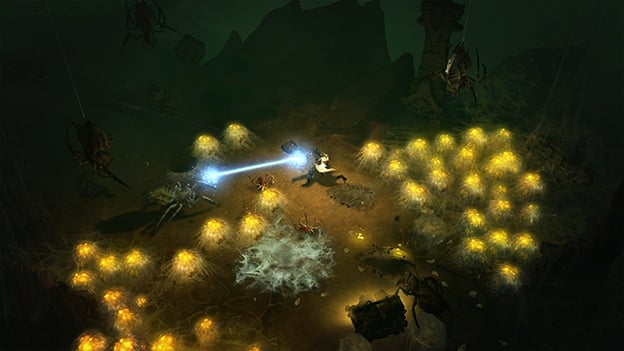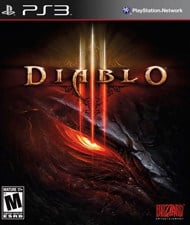Dungeon Crawling For The Console Crowd
Diablo III for consoles could have been so much less than what it turned out to be. Blizzard could have easily ported the game to the PS3 and Xbox 360 back at the time of release, and probably would have made a ton of money doing so. But the result would have been a disaster. Essentially, you would have been trying to play a PC game on a console, with a poorly translated control scheme and visuals far above the capability of the hardware. The fallout from gamers would have been harsh, and Blizzard employees may have had to play a real-life version of Diablo , with gamers replacing the demons just to get to their cars at the end of the workday. But, thankfully, Blizzard waited 18 months and released a polished, fully functional, dungeon-crawling slaughterfest worthy of the Diablo name.
I’m not going to sit here and compare the technical specifications of the PC version to the console version. I have no intentions of letting this review devolve into a chart of frame-rate comparisons. We all know that Diablo III looks better on a powerful PC, and that’s not going to change. But the simple fact is this–not every PC is the same. Countless hardware variations mean that not all PC gamers have the same experience with a game, and most PCs don’t have the horsepower to run new games at full settings. This gives the console market one advantage over PC– they are all the same . Every gamer who picks up a copy of Diablo III for PS3 will be able to enjoy it the way it was intended for the console. The same goes for Xbox 360 gamers. While the visual prowess of these console competitors can’t compare to the might of a high-end gaming PC, their stability and mass appeal are unquestionable. Thus is the genius of a quality console port for this game–it just makes sense.
I did encounter a few frame-rate issues during my time with the game, but they were few, and generally had no impact on the gameplay. Of course, character models and scenery are scaled back for the console version, but the game still looks great. Stellar particle effects, animations, and the game’s ability to display hordes of enemies on-screen at once are impressive, especially given the amount of demon-head-stomping and exploding corpses my Barbarian caused in his rage-fueled wake.
Then, there are the glorious cutscenes. One of Blizzard’s trademark talents, these cutscenes are astounding. They’ve lost nothing in the transition from PC to console, and I found myself picking my jaw up from the floor any time I was watching one.
Now that we have the visuals out of the way, let’s talk about the other elephant in the room–the control scheme. Yes, it is true, if you are making the conversion from PC to console with Diablo III , you are going to lose some controllability. I mean, I suppose someone could strap a keyboard to a PS3 controller and sell it specifically for this game, but I just don’t think it would work the same.

However, this simplified approach brings with it several perks that I found quite enjoyable, such as using the thumbsticks for movement. Though it has been the staple of Diablo and many other Blizzard games forever, the point-and-click character movement is gone in this version. Not only that, but your second thumbstick gives you a directional evade capability, which is invaluable during combat and is easily accessible. Your character’s abilities are mapped to the controller face-buttons, while shoulder buttons are used for items and special abilities. All-in-all, I found that this streamlined design kept me focused on the fun of the game, rather than programming macros on my gaming keyboard or figuring out how to raise my DPS by stringing my abilities together in a certain way. While the controls of both the PC and console versions have their strengths, I feel like I had more pure fun with the console release.

The story of the game is exactly the same as the PC version, so if you liked it before, chances are you will like it again. But for those of you who haven’t played the PC version, let me break it down for you. No matter which character class you choose, you will start your journey in New Tristram, the site of the town where it all began in the original Diablo . From that hub, you will adventure throughout the countryside to face grotesque demons and undead foes, above and below ground. In New Tristram, you will meet Leah, a girl with enormous power and no idea how to control it, Deckard Cain, Leah’s uncle and local doomsayer, and the stranger, a guy who, quite literally, fell from the sky. Confused yet? Good. If you want to know any more, you will have to play the game for yourself. The three-act story is solid and, in the tradition of the Diablo name, rarely misses a step.
Adding to the already complete package, I am happy to report the soundscape of Diablo III survived the console transition unscathed. The voice-acting is solid throughout, but it can get cheesy at times, even though it seems intentional. The sound effects are excellent, and the unique ambient score sets the tone for dungeon-raiding goodness.

Though Diablo III is a wholly fulfilling single-player experience, everything is better with friends, and this is no exception. This console port that seems to be concentrated solely on the fun of the game adds a few features to the multiplayer that are worth a look. The fun of the game speaks for itself, and the difficulty level of your game scales up with the amount of players fighting in your party. This is nothing new, but it definitely keeps things interesting. Additionally, there are several facets to the game that are specific to every player in the party, which is impressive. Loot drops, cutscenes, and dialogue are unique to each player during a multiplayer session. This means no fighting over the best loot, you don’t have to watch a different character’s cutscenes, and dialogue that you initiate (with the exception of main-story dialogue) doesn’t clutter your sound up and take you out of what you’re doing. Somehow, Blizzard managed to let players play alongside one another without keeping the annoyances that typically come with the territory. Add to that the removal of the auction house and the lack of an online requirement, and you may very well have the game that gamers were looking for 18 months ago.
So, PC gamers, burn effigies if you must, but I enjoyed Diablo III way more on console than I did on PC. There, I said it. This is simply because this version is more focused on the fun of the franchise instead of trying to turn a beloved dungeon-crawler into an MMO. No matter how you play it, though, Diablo III is the pinnacle of its genre, especially on consoles. Unfortunately, I fear that those loyal to PC gaming will never get to experience the game in this form, and that’s a shame. Now, if I can only find that damn cow level…
RATING OUT OF 5 RATING DESCRIPTION 4.0 Graphics
Though visually less impressive than its PC counterpart, it has the added bonus of console stability. 4.5 Control
The remapped control scheme is easy to learn and movement with the control sticks works great. 4.5 Music / Sound FX / Voice Acting
Everything about this soundscape is high quality. 5.0 Play Value
There’s no denying it, Diablo III is ridiculously enjoyable demon-slaying fun. 4.5 Overall Rating – Must Buy
Not an average. See Rating legend below for a final score breakdown.
| Review Rating Legend | |||
|---|---|---|---|
| 0.1 – 1.9 = Avoid | 2.5 – 2.9 = Average | 3.5 – 3.9 = Good | 4.5 – 4.9 = Must Buy |
| 2.0 – 2.4 = Poor | 3.0 – 3.4 = Fair | 4.0 – 4.4 = Great | 5.0 = The Best |
Game Features:
